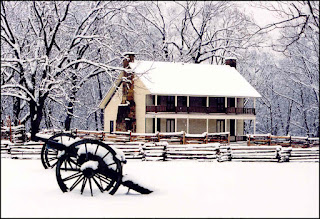 |
| Elkhorn Tavern in the Snow National Park Service |
The winter of 1861-1862 was remarkably cold in the Ozarks region of northern Arkansas, even though it was strangely warm deeper in the Deep South.
From Alabama and Mississippi, for example, there were reports that meat was spoiling because there had been no proper "hog killing weather." In Arkansas, however, the snows were piling up. Letters written home to Louisiana by soldiers serving under Colonel Louis Hebert, for example, described snow accumulating to depths of between one and two feet in Benton County.
 |
| Ice Storm at Pea Ridge Battlefield National park Service |
They also were as well-fed as any army in the field at that time. The Arkansas River had been running high through the winter, allowing steamboat traffic to continue at a brisk pace between Little Rock and Fort Smith. The latter city was a major supply center for Confederate troops serving in the West and a steady stream of supply wagons made its way up and over the Boston Mountains with provisions, clothing, shoes, weapons and other necessities for the troops in Washington and Benton Counties.
 |
| Gen. Earl Van Dorn, CSA |
Meanwhile, elsewhere in Arkansas, General Earl Van Dorn had arrived in Pocahontas and appeals had been issued for the men of Arkansas to enlist in his army as quickly as possible. In every county of the state, new companies were forming and preparing to march in response to the calls of General Van Dorn and Governor Rector. An army was forming of sufficient size to approach the Union onslaught that was expected to come down from Missouri in the spring.
I will continue posting on the 150th anniversary of the Battle of Pea Ridge over coming days and weeks, so please check back often. You can read more about the battle anytime at www.exploresouthernhistory.com/pearidgeindex.
No comments:
Post a Comment